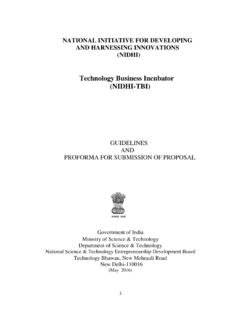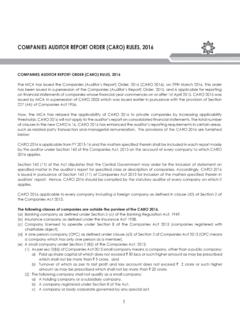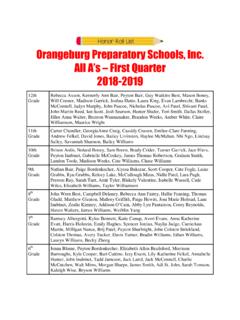Transcription of The World Bank Group 1818 H Street, N.W. Washington, D.C ...
1 Independent Evaluation Group The World Bank Group designing a 1818 H Street, Washington, 20433, Telephone: 202-477-1234. Facsimile: 202-477-6391. results framework Internet: Independent Evaluation Group Strategy, Learning, and Communication for achieving E-mail: Telephone: 202-458-4497. Facsimile: 202-522-3125. results: a how-to guide 4. 1. designing a results framework for achieving results: a how-to guide The World Bank I ndependent E valuation G roup Washington, 2. Acknowledgements This booklet was written by Dawn Roberts (independent consultant). and Nidhi Khattri (IEG). Peer review comments from Susan Stout (consultant) and Maurya West Meiers (IEG) are gratefully acknowledged. The task manager for the work was Nidhi Khattri. The IEG Blue Booklet series disseminates practical information on various aspects of monitoring and evaluation.
2 Objectives of the series are to focus on implementation aspects of monitoring and evaluation and to disseminate information on other sources of knowledge. The series is prepared under the overall guidance of Hans-Martin Boehmer, Senior Manager, IEGCS. 2012 Independent Evaluation Group Strategy, Learning, and Communication International Bank for Reconstruction and Development/ World Bank 1818 H Street, Washington, DC 20433. Email: Telephone: 202-458-4497. Facsimile: 202-522-3125. Internet: All rights reserved ISBN-13: 978-1-60244-220-7. ISBN-10: 1-60244-220-7. The opinions expressed in the report do not necessarily represent the views of IEG/. the World Bank Group or its member governments. IEG/the World Bank Group do not guarantee the accuracy of the data included in this publication and accept no responsibility whatsoever for any consequence of their use.
3 2. Table of Contents 5. What Is a Results Framework?.. 7. Uses of Results 14. What Is Required to Design a Results Framework? .. 20. Understanding of Problem and Needs 20. Specifying the Theory of 21. Step-by-Step 26. Step 1. Establish Strategic Objective(s) for the Problem(s) to Be 26. Step 2. Identify and Work with 27. Step 3. Define Results (Outputs and Outcomes).. 28. Step 4. Identify Critical Assumptions and 29. Step 5. Review Available Data Sources and Specify 29. Step 6. Assign Indicators and Data Sources for Each Level of Step 7. Establish the Performance Monitoring 38. Step 8. Establish a Communication and Dissemination 40. 41. 43. 3. 4. 5. Introduction It is difficult to know if programs have succeeded or failed if the expected results are not clearly articulated.
4 An explicit definition of results . precisely what is to be achieved through the project or program and by when keeps measurable objectives in sight, helps monitor progress toward those objectives, and assists with adjustment and management of program implementation. Results-based management is a key tool for development effectiveness. Recent years have witnessed a trend in explicitly specifying the results (outcomes and impacts) of both broader country strategies and more specific programs and projects. Internationally agreed principles have underpinned this push for results, most notably with the adoption of the United Nations Millennium Declaration (2000), which established the Millennium Development Goals with targets and indicators to provide the basis for measuring progress and the effectiveness of aid.
5 Landmarks in this emerging results orientation include the Monterrey Consensus (2002), the Rome Declaration on Harmonization (2003), the Paris Declaration (2005), the Hanoi Conference on Managing for Development Results (2007), the Accra Agenda for Action (2008), and the Busan Partnership for Effective Development Cooperation (2011). Each of these agreements underscored the importance of increased accountability of governments, donor agencies, and other partners toward the achievement of results. A results framework serves as a key tool in the development landscape, enabling practitioners to discuss and establish strategic development objectives and then link interventions to intermediate outcomes and results that directly relate to those objectives.
6 This publication provides how-to guidance for developing results frameworks by discussing the following: The definition of a results framework. What is it? How does a results framework complement and differ from a traditional monitoring and evaluation logical framework? 6 Designing a R e s u lt s F r a m e w o r k for A c h i e v i n g R e s u lt s Uses for results frameworks. What are the functions of a results framework? At what levels can one be developed and used effectively? Requirements to design a results framework. Is there an assessment and diagnosis process to understand the problem and desired results before the design and implementation of the intervention is developed? Does the team adequately understand the problem that a development intervention is designed to address?
7 Has the program or project logic been defined? Designing a results framework step by step. What are the steps in formulating a results framework? How should practitioners establish strategic objectives and articulate the expected results? What is the process through which results, indicators, and data sources can be assigned for each level of desired result (output, outcome, and impact)? What are the criteria for designing a useful results framework? Who should be involved in developing and using the framework? Challenges. What are the potential pitfalls in developing results frameworks? What strategies help in avoiding these? This publication also provides various examples or excerpts of results frameworks used at various levels (for example, country, project, and organization) and offers references for further support to practitioners in designing and using results frameworks for development effectiveness.
8 For more on context, see Binnendijk (2000) and OECD-DAC (2008). 7. What Is a Results Framework? A results framework is an explicit articulation (graphic display, matrix, or summary) of the different levels, or chains, of results expected from a particular intervention project, program, or development strategy. The results specified typically comprise the longer-term objectives (often referred to as outcomes or impact ) and the intermediate outcomes and outputs that precede, and lead to, those desired longer-term objectives. Although the World Bank has used the term results framework over the last decade, similar conceptual tools, also designed to organize information regarding intended outcomes and results, are used across different agencies: logical frameworks, logic models, theories of change, results chains, and outcome mapping.
9 Thus, the results framework captures the essential elements of the logical and expected cause-effect relationships among inputs, outputs, intermediate results or outcomes, and impact. There are many debates, and considerable controversy, on the distinctions among outputs, outcomes, and impact. A generally useful approach is to consider outputs as the particular goods or services provided by an intervention (for example, nutrition supplements), whereas an outcome is usefully thought of as benefits of that particular good or service to the target population (such as improved nutrition intake), and impact refers to evidence on whether outcomes are actually changing beneficiary behavior or longer-term conditions of interest (for example, improved eating habits, a healthier population).
10 The key is to distinguish between the provision of goods and services (which involves supply-side activities) and actual demand for and/or utilization of those goods and services (demand-side response). Defining cause-effect linkages for one or more interventions lays the groundwork for a results framework. Thus, the development of a good results framework requires clarity with respect to the theory of change the reasons why the project, program, or strategy will lead to the outputs; why those outputs are likely to lead to the immediate or intermediate outcomes; and how those outcomes are (at least hypothetically) linked with longer-term outcomes or impact. The 8 Designing a R e s u lt s F r a m e w o r k for A c h i e v i n g R e s u lt s theory of change also requires knowing or estimating how long it will take to achieve each stage of the program and how much of the outcome is likely to be achieved.















